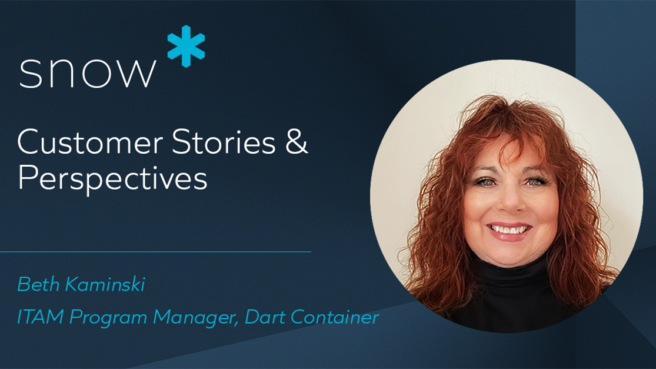What Do SAMs Have in Common With Window Dressers?

Have you ever visited New York City during the holidays? The imagination, attention to detail and creativity that goes into window designs is amazing and causes passers-by to stop to view the high-fashion mannequins standing in their own bubble of perfection. But, as you walk by, have you ever considered the real people behind those mini realities designed to sell passers-by everything from clothes to beach coolers? As retail shifts to online sales, window dressers may not be as widespread of a profession these days, but they still have a lot in common with software asset managers (SAM), says ITAM/SAM industry veteran and Snow customer, Beth Kaminski.
Kaminski is the ITAM Program Manager for Dart Container, the world’s largest manufacturer of food service packaging and beverage solutions headquartered in Mason, Michigan, with 45 locations. Early in her career, she was a window dresser for several retailers. In a recent sit-down, she explained how the two roles are strikingly similar.
How did you get started in the profession and what is it like?
KAMINSKI: I started dressing mannequins and creating store displays when I was in high school. Then I put myself through college dressing windows. When I graduated, I was ready to burn down the world, but I ended up working as an assistant manager for a large retailer and I went back to dressing more windows. When I tell people about my time as a window dresser, most say, ‘isn’t that interesting’ and ‘I’ve never known anyone who did that.’ For all the SAM professionals, that probably sounds familiar. Asset management may be a growing field, but it’s still small and a unique part of most organizations.
How is the job similar to a SAM’s role?
KAMINSKI: Organizationally, both roles are unique. As a window dresser, you aren’t a part of any one department: you’re working for every department. You’re serving the entire store. It’s the same for SAMs. You work enterprise-wide and early-on, you learn it’s your job to constantly consider the bigger picture.
For window dressers, it’s when someone sells all the clothes out of one of your windows and, suddenly, refilling that window becomes your next task. No one wants naked mannequins. It’s the same for SAMs. In my role today, when we receive an audit letter, we suddenly have to shift our focus. There’s little routine in both jobs. Instead, it’s a reflection of what’s happening in the organization and the market at any given time.
What have you learned from being a window dresser that has helped you in your role today?
KAMINSKI: Right away, I can think of one very important example – the need to know how to pivot quickly and be agile. I remember working with an absolute genius while I was in college. He and I created a beautiful bridal window and as soon as we locked the door on our work, a customer said she wanted to try on the wedding dress. He had a fit, complaining she was messing up his work. That’s a good example of why, as window dressers, we needed to remember why we do what we do – it’s to peak customer interest and sell merchandise. We have to go with the flow.
It’s the same for SAMs. We have to be agile; we have to pivot around what is important at the time, even if it means tearing out the work you just completed. You just have to roll with it. And like window dressers, SAMs are also trying to sell an idea. In a store window, you might be designing a fun beach window, but the ultimate goal is to sell beachwear. In SAM, you may know your organization needs a SaaS management tool, so what do you do? You have to sell the idea to management. You might start with how the tool will help formulate the organization’s SaaS strategy or how it will help protect the strategy. Or, how it will improve overspend on SaaS licenses. Once again, you have to pivot from idea to idea, depending on what’s happening in your organization, and sell it.
When selling your idea, it’s critical to know what your audience needs. Each executive has a different take on what they need from a SAM manager to make a strategy or technology decision. Some want numbers, and others want industry comparisons. It’s the same as doing a winter scene in a store window. You know the goal – now you have to find the right winter boots and coats to sell it. So what will most effectively promote your idea? Both SAMs and window dressers are marketers in that way. And knowing your audience is key.
To learn more about our featured guest Beth Kaminski, check out her bio on LinkedIn.
This post is part of a series of blogs that highlight IT practitioners and their on-the-job experiences, diverse backgrounds and what it means to work in IT today.
If you’d like to share your story with Snow readers or nominate an ITAM/SAM star to tell theirs, please send an email to kathleen.shepherd@snowsoftware.com.